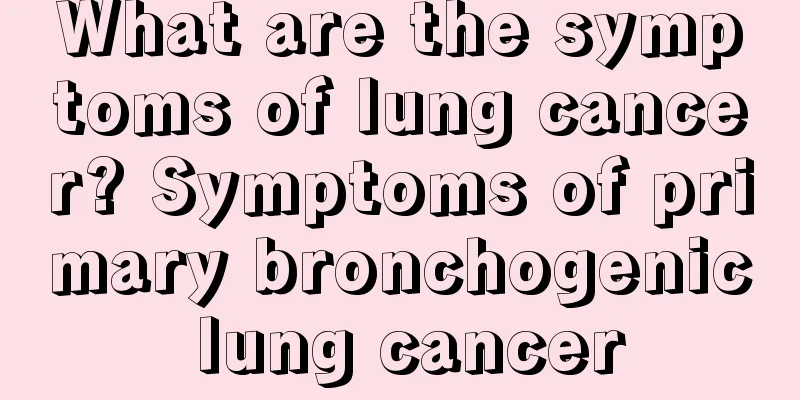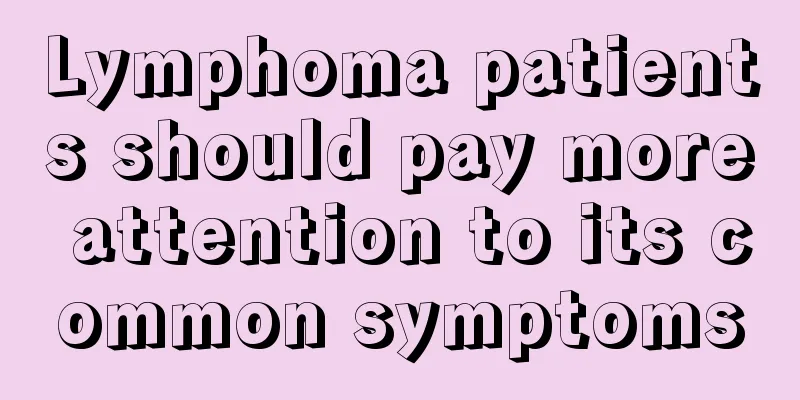What are the symptoms of lung cancer? Symptoms of primary bronchogenic lung cancer

|
Primary bronchogenic lung cancer is a common malignant tumor. After the disease is discovered in the early stage, the cure rate can reach 80% if it is treated as soon as possible. However, if the disease develops to the late stage, it may affect physical health. Therefore, patients must understand the early clinical manifestations of the disease and discover the disease as soon as possible to determine the symptomatic treatment plan. Primary bronchogenic lung cancer is a very complex disease that can cause a lot of harm after onset. If you want to diagnose the disease in the early stages, you must understand the relevant clinical manifestations to ensure that the disease can be discovered in time so that you can determine the symptomatic treatment plan in the later stages. Let's take a closer look at the symptoms of primary bronchogenic lung cancer. First, after primary bronchial lung cancer occurs, tracheal tumors can cause large airway stenosis. Because the cancerous tissue is rich in blood vessels and some tissues are necrotic, hemoptysis is also the primary symptom of lung cancer. In the later stage, as the disease progresses, there will be blood in the sputum, which is caused by the disease corroding the large blood vessels, especially the partial bronchial obstruction caused by the tumor, which can cause wheezing in some lung cancer patients. Second, when the tumor causes bronchial stenosis or the tumor metastasizes to the hilar lymph nodes and compresses the main bronchus or carina, it will metastasize to the pleura and produce a lot of pleural effusion. When it metastasizes to the pericardium, it will produce pericardial effusion, diaphragmatic paralysis, superior vena cava obstruction and extensive lung fatigue, which can affect lung function and cause chest tightness and difficulty breathing. Third, weight loss is also a common symptom of primary bronchogenic carcinoma. When lung cancer develops to the late stage, tumor toxins will cause weight loss or cachexia. Subsequent tumor tissue necrosis can cause fever, and antibiotic treatment will have a better effect at this time. Fourth, the clinical manifestations of primary bronchogenic carcinoma include extrapulmonary manifestations caused by the impact of cancer on other systems, mainly abnormal changes in the endocrine, neuromuscular, connective tissue, blood system and blood vessels. Common manifestations include hypertrophic pulmonary osteoarthropathy, symptoms and signs caused by the secretion of gonadotropin, adrenaline and antidiuretic hormone, etc. The pathological conditions of primary bronchogenic lung cancer have been understood. After the patients have analyzed it clearly, they can determine the treatment plan based on different pathological characteristics. After all, the early, middle and late stage symptoms are different, and the treatment methods are also different. It is recommended that patients go to the hospital for examination as soon as possible and follow the doctor's instructions to improve their condition, otherwise the symptoms will worsen and cause more harm. |
Recommend
Seven kinds of water for foot soaking have miraculous effects
1: Why can soaking your feet at night replenish b...
What are the symptoms of non-ejaculation?
Generally speaking, when men and women have sex, ...
How to quickly deal with numb legs from squatting
Some mothers like to squat and pick vegetables af...
What are the symptoms of pneumothorax
The occurrence of pneumothorax usually has some p...
Do you know why your waist hurts when you bend over?
It is very important for the human body. Whether ...
What are the main functions of Maca?
If sexual function is reduced, it is a very painf...
Is TCM effective in treating the spleen?
Symptoms of disease in any organ of the body will...
What are the examination items for bladder cancer bone metastasis
Bladder cancer refers to a malignant tumor that o...
Can breast cancer patients eat beef and mutton?
Breast cancer patients can eat beef and mutton in...
What is the reason why clothes turn yellow?
We often find that some white clothes will turn y...
What are the symptoms of food inhalation?
It is not uncommon for food to go into the trache...
Should I take CT or X-ray for a fracture
After a fracture occurs, first aid measures shoul...
What is the difference between chemotherapy and no chemotherapy for advanced gastric cancer?
What is the difference between chemotherapy and n...
Can nasopharyngeal cancer cause facial paralysis?
Can nasopharyngeal cancer cause facial paralysis?...
How to moisturize lips more effectively
Maybe in life, many people pay more attention to ...









